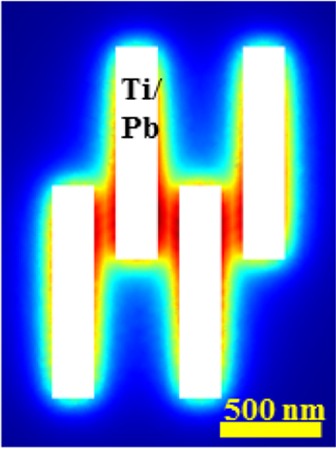Mesoscopic Josephson junctions with lead electrodes

When two superconducting materials are separated by a very thin (less than 10-8 m or 10 nanometers) layer of an insulating material at very low temperature some peculiar electrical effects can be detected called Josephson effects.
If normal conducting metals are separated by such a barrier in that conditions it is possible for a small current to flow between the conductors by the tunnel effect, a typical quantum mechanical phenomenon.
But if the materials are superconductors some unusual phenomena occur. First, a supercurrent, a current with zero resistance, that is, can flow through the barrier. If this current exceeds a critical value, this conductivity is lost; the barrier then only allows the small current flow due to the tunnel effect and a voltage develops across the junction. If we apply a magnetic field below the critical current value we will find that the net current through the barrier depends on the magnetic field that we are applying. If the field increases beyond a critical value the supercurrent vanishes.
A junction like the one we have just described is called a Josephson junction; two or more of them joined by superconducting paths is called a Josephson interferometer. These junctions can be used in measuring fundamental constants, in defining a voltage standard or to measure magnetic fields accurately. An important potential use is in logic components in high-speed computers. Josephson junctions can switch states very quickly (as low as 6 picoseconds). Moreover, they have very low power consumption and can be packed closely without generating too much heat.
Josephson junctions and coherent quantum transport have been attracting interest in recent years due to the development of modern nanofabrication techniques, which enable the fabrication of nanoscale hybrid superconducting devices in a broad range of designs and materials. Josephson junctions realized with semiconductor nanowires have shown a high potential in different types of nanoscale devices demonstrating, for example, tunable supercurrents, the supercurrent reversal, and the suppression of supercurrent by hot electron injection.
Currently, the vast majority of the studies of nanowire-based Josephson junctions rely on aluminium superconducting electrodes, thus limiting the operation to a maximum of 1.2 K, which corresponds to the critical temperature of the aluminium-based leads. Now, in a world first, a group of researchers from the NEST/Istituto Nanoscienze-CNR in collaboration with Sebastian Bergeret from Materials Physics Center UPV/EHU-CSIC and DIPC, have built1 indium arsenide (InAs) nanowire Josephson junctions using lead (Pb) superconducting leads, with a critical temperature of ~7.2 K, and tested their response as as a function of temperature and in the presence of an external perpendicular magnetic field.

The InAs nanowires were grown epitaxially on InAs (111) substrates. Then transferred mechanically to a silicon substrate where leads of titanium/lead (10/80 nm) were deposited using an evaporation technique at room temperature. The end results are mesoscopic Pb/InAS-nanowire/Pb Josephson junctions with ~100 nm interelectrode spacing (see Figure 2).
What the researchers found was that the devices show excellent properties in terms of a high critical current exceeding 600 nA and an observable Josephson current at temperatures up to 4.5 K and magnetic fields up to 0.3 T. Superconductivity is observed in the electrodes up to ∼7 K.
But they also detected an unexpected behaviour. As well as the choice of materials, the dimensions and geometry affect the performance of mesoscopic Josephson junctions. In principle, for junctions with the ratio W/L (W is the width and L the length of the junction) smaller than unity the critical supercurrent is expected to decrease monotonically as a function of the external perpendicular magnetic field instead of showing a Fraunhofer diffraction pattern typical of wide junctions. Unlike the expected behavior in narrow junctions where the width is smaller than the magnetic length, they observed a marked diffraction pattern of the critical current as a function of the magnetic field that can be explained by a strong magnetic flux focusing provided by the lead electrodes.
These results combined with the ease of evaporation makes lead a promising and solid alternative to other superconducting metals as a contact electrode material.
Author: César Tomé López is a science writer and the editor of Mapping Ignorance.
References
- J. Paajaste, M. Amado, S. Roddaro, F. S. Bergeret, D. Ercolani, L. Sorba, and F. Giazotto (2015) Pb/InAs Nanowire Josephson Junction with High Critical Current and Magnetic Flux Focusing Nano Letters DOI: 10.1021/nl504544s ↩